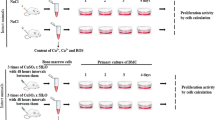Summary
Effects of the environmental microflora on rat liver were studied in the present investigation. Rats born under sterile conditions were bred either in a germfree or in a “SPF” environment. At 12 weeks of age the liver of the SPF rats was larger by 20% and contained more DNA than germfree rat liver. Volume analysis, by means of a particle counter, of isolated nuclei suggested that the increase of DNA was due to an increase of hepatic nuclear ploidy. The findings show that infections may influence liver size and ploidy. They indicate that the state of infection should be controlled in animal studies which concern the regulation of liver growth and ploidy or which use liver weight and DNA as reference standards.
Zusammenfassung
In der vorliegenden Arbeit werden Einflüsse der Mikroflora auf die Rattenleber beschreiben. Die Ratten wurden unter sterilen Bedingungen geboren und entweder in einer keimfreien oder einer «SPF»-Umgebung aufgezogen. Im Alter von 12 Wochen wurden die Tiere getötet. Die Leber de SPF-Ratten war um 20% größer und enthielt mehr DNA als die Leber der keimfreien Ratten. Volumenanalyse an isolierten Zellkernen mittels eines Partikelzählgerätes ergab, daß die Zunahme der DNS auf einer Zunahme der Ploidie der hepatischen Zellkerne beruht. Die Ergebnisse zeigen, daß Infektionen die Lebergröße und die Kern-Ploidie im Organ verändern können. Der Infektionsstatus der Versuchstiere sollte daher bei Untersuchungen kontrolliert werden, die die Regulation von Leberwachstum und Ploidisierungsvorgängen betreffen oder in denen Gewicht und DNS-Gehalt der Leber als Bezugsgrößen verwandt werden.
Similar content being viewed by others
References
Burton, K.: A study of the conditions and mechanism of the diphenylamine reaction for the colorimetric estimation of deoxyribonucleic acid. Biochem. J.62, 315–323 (1956).
Carriere, R.: The growth of liver parenchymal nucleic and its endocrine regulation. Int. Rev. Cytol.25, 201–277 (1969)
Casanello, D. E., Gerschenson, L. E.: Some morphological and biochemical characteristics of isolated rat liver cells dissociated with sodium tetraphenylboron and cultured in suspension. Exp. Cell Res.59, 283–290 (1970)
Chauveau, J., Moulé, Y., Rouiller, Ch.: Isolation of pure and unaltered liver nuclei. Morphology and biochemical composition. Exp. Cell Res.11, 317 (1956)
Doljanski, F.: The growth of the liver with special reference to mammals. Int. Rev. Cytol.10, 217–241 (1960)
Falzone, J. A., Barrows, C. H., Yiengst, M. J.: Fractionation of rat liver nuclei into diploid and tetraploid DNA classes by continuous density gradient sedimentation. Exp. Cell Res.26, 552–561 (1962)
Gerhard, H., Schultze, B., Maurer, W.: Die Proliferation des Gallengansepithels bei der Regeneration der CCl4-Leber der Maus. Virchows Arch. B Cell Path.17, 213–227 (1975)
Johnston, I. R., Mathias, A. P., Pennington, F., Ridge, D.: Distribution of RNA polymerase activity among the various classes of liver nuclei. Nature (Lond.)220, 668–672 (1968)
Leduc, E. H.: Mitotic activity in the liver of the mouse during inanition followed by refeeding with different levels of protein. Amer. J. Anat.84, 397–429 (1949)
Lentz, P. E., Di Luzio, N. R.: Biochemical characterization of kupffer and parenchymal cells isolated from rat liver. Exp. Cell Res.67, 17–26 (1971)
Preis, C., Schaude, G., Siess, M.: Histometrische Analyse der Lebervergrößerung nach chronischer Einwirkung von Barbituraten und Halothan. Naunyn-Schmiedebergs Arch. Pharmakol. exp. Path.254, 489–504 (1966)
Rappaport, C., Howze, G. B.: Dissociation of adult mouse liver by sodium tetraphenyl-boron, a potassium complexing agent. Proc. Soc. exp. Biol. (N.Y.)121, 1010–1017 (1966)
Schulte-Hermann, R., Thom, R., Schlicht, I., Koransky, W.: Zahl und Ploidiegrad der Zellkerne der Leber unter dem Einfluß körperfremder Stoffe. Naunyn-Schmiedebergs Arch. Pharmakol. exp. Path.261, 42–58 (1968)
Schulte-Hermann, R., Koransky, W., Leberl, C., Noack, G.: Hyperplasia and hypertrophy of rat liver induced by α-hexachlorcyclohexane and butylhydroxytoluene. Retention of the hyperplasia during involution of the enlarged organ. Virchows Arch. Abt. B9, 125–134 (1971)
Schulte-Hermann, R.: Induction of liver growth by xenobiotic compounds and other stimuli. Crit. Rev. Toxicol.3, 97–158 (1974)
Sudweeks, A. D., Hill, R. B.: Control of liver cell replication by albumin need. J. Cell Biol.34, 404–406 (1967)
Wheatley, D. N.: Binucleation in mammalian liver. Exp. Cell Res.74, 455–465 (1972)
Weibel, E. R., Stäubli, W., Gnägi, H. R. Hess, F. A.: Correlated morphometric and biochemical studies on the liver cell. I. Morphometric model, stereologic methods, and normal morphometric data for rat liver. J. Cell Biol.42, 68–91 (1969)
Author information
Authors and Affiliations
Rights and permissions
About this article
Cite this article
Hermann, R.S., Deerberg, F. & Landgraf, H. Changes in size, DNA content, and nuclear ploidy of rat liver produced by the environmental microflora. Virchows Arch. B Cell Path. 20, 71–76 (1976). https://doi.org/10.1007/BF02890327
Received:
Issue Date:
DOI: https://doi.org/10.1007/BF02890327



